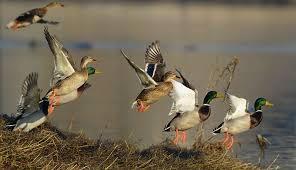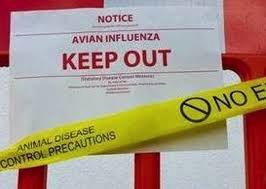 USDA-APHIS has reported isolation and outbreaks of H5N1 avian influenza in nine backyard flocks and on ten commercial farms. The common virus responsible has HA genes of Eurasian lineage. Outbreaks should be viewed against the extensive recovery of virus from migratory waterfowl in the Atlantic Flyway. From January 3rd through February 23rd, surveillance has yielded H5N1 or H5 virus from 297 hunter-killed ducks of various species. States from which isolates have been recovered extending southward along the Atlantic Flyway include New Hampshire, Connecticut, Delaware, Virginia, North Carolina, South Carolina, Georgia, and Florida. As yet there have been no reports on surveillance in progress on migratory birds along the Mississippi Flyway although it is recognized that sampling was belatedly initiated in mid-February. The fact that outbreaks have occurred in Indiana, Kentucky and Michigan suggests infection of migratory waterfowl in the Mississippi Flyway.
USDA-APHIS has reported isolation and outbreaks of H5N1 avian influenza in nine backyard flocks and on ten commercial farms. The common virus responsible has HA genes of Eurasian lineage. Outbreaks should be viewed against the extensive recovery of virus from migratory waterfowl in the Atlantic Flyway. From January 3rd through February 23rd, surveillance has yielded H5N1 or H5 virus from 297 hunter-killed ducks of various species. States from which isolates have been recovered extending southward along the Atlantic Flyway include New Hampshire, Connecticut, Delaware, Virginia, North Carolina, South Carolina, Georgia, and Florida. As yet there have been no reports on surveillance in progress on migratory birds along the Mississippi Flyway although it is recognized that sampling was belatedly initiated in mid-February. The fact that outbreaks have occurred in Indiana, Kentucky and Michigan suggests infection of migratory waterfowl in the Mississippi Flyway.
The backyard outbreaks with date confirmed by the NVSL* comprised:-
- February 12th Fauquier County, VA.
- February 18th Suffolk County, NY.
- February 19th Knox County, ME
- February 23rd Knox County, ME.
- February 23rd Kalamazoo County, MI.
- February 24th Ulster County, NY.
- February 24th Duchess County, NY.
- March 2nd Pottawatomie County, IA.
- March 2nd Undisclosed County, CT.
The outbreaks in commercial flocks with the date confirmed by the NVSL* comprised:-
- February 8th Dubois County, IN. Turkeys, (‘Dubois 1’)
- February 12th Fulton County, KY. Broilers (‘Fulton1 and 2’)
- February 15th Webster County, KY Turkeys.
- February 16th Dubois County, IN. Turkeys (’Dubois 2)
- February 23rd Newcastle County, DE. Egg-production complex
- February 23rd Greene County, IN (‘Greene 1’)
- February 23rd Greene County, KY. Turkeys (‘Greene 2’)
- February 24th Dubois County, IN. Turkeys (‘Dubois 3’)
- March 1st Dubois County, IN. Turkeys (‘Dubois 4’ presumptive)
* Field diagnosis and presumptive state laboratory diagnosis with flock depletion would have beeen made a few days before official confirmation by NVSL
 A total of 170,000 growing turkeys were depleted in Indiana and 250,000 broilers and 55,000 turkeys in Kentucky. The Delaware farm held 1.2 million laying hens
A total of 170,000 growing turkeys were depleted in Indiana and 250,000 broilers and 55,000 turkeys in Kentucky. The Delaware farm held 1.2 million laying hens
Doubtless there will be more isolates from migratory waterfowl with the extent and frequency a function of the intensity of surveillance. Backyard flocks that are allowed outside access will be at risk of infection although these clusters of birds in suburban aras are of minimal significance in the epidemiology of avian influenza in the commercial industry. Outbreaks in commercial flocks are to be expected with sporadic cases diagnosed as an index flock followed by subsequent diagnoses in contact flocks. These secondary cases are to be expected within the same complex or farms having a common feed supplier or service personnel.
The level of biosecurity in commercial poultry production complexes is infinitely higher than in 2015 when the U.S. experienced an epornitic along the Mississippi Flyway The response of state and federal authorities sice this time is rapid and effective both in diagnosing and depleting affected flocks. To date, all nine floor-housed flocks that were infected were depleted using foam.
It would be helpful for APHIS epidemiologists to rapidly investigate outbreaks on commercial farms and to identify the possible routes of infection and whether any obvious defects in structural or operational biosecurity were present that contributed to outbreaks. This would provide the industry with valuable information to implement appropriate preventive action and to allocate additional resources to intensified biosecurity. A preliminary opinion in March 2022 will be more valuable than a comprehensive document in 2023 or later.